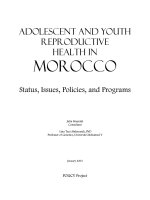Tài liệu Reproductive health in male systemic lupus erythematosus pdf
Bạn đang xem bản rút gọn của tài liệu. Xem và tải ngay bản đầy đủ của tài liệu tại đây (479.7 KB, 8 trang )
215Bras J Rheumatol 2009;49(3):207-22
ORIGINAL ARTICLE
Received on 11/03/2008. Approved on 02/18/2009. CA Almeida received grant from remanescent funds from SBR.
Pediatric Rheumatology Unit of the Department of Pediatrics, Rheumatology and Urology courses, and Department of Radiology, Faculdade de Medicina,
Universidade de São Paulo (FMUSP)
1. Associate Professor of the Department of Pediatrics at FMUSP. In charge of the Pediatric Rheumatology Unit at the Instituto da Criança (ICr), Hospital das
Clínicas (HC), Faculdade de Medicina da Universidade de São Paulo (FMUSP)
2. Full Professor of the Rheumatology Division of the HC-FMUSP
3. Associate Professor and Assistant Physician of the Rheumatology course at HC-FMUSP
4. Biomedical Scientist of the Division of Andrology at the Human Reproduction Center at HC-FMUSP
5. Doctor of Science, FMUSP
6. Master of Science, FMUSP. Professor of the Department of Pediatrics at Universidade Federal do Pará
7. Doctor in Radiology, FMUSP. Physician in charge of the Division of Ultrasonography of Small Parts at the Department of Radiology at HC-FMUSP
8. Assistant Physician of the Urology course at HC-FMUSP. In charge of the Division of Andrology at the Human Reproduction Center at HC-FMUSP
Correspondence to: Prof. Dr. Clovis Artur Almeida da Silva. Rua Araioses, 152/81 – Vila Madalena, São Paulo – SP, Zip Code – 05442-010. Fax: 55 (11) 3069-
8503. E-mail:
Reproductive health in male
systemic lupus erythematosus
Clovis Artur Almeida da Silva
1
, Eloísa Bonfá
2
, Eduardo Ferreira Borba
3
, Aline Presto Braga
4
,
Pollyana Maria Ferreira Soares
5
, Ana Julia Pantoja de Moraes
6
, Osmar Saito
7
, Marcello Cocuzza
8
INTRODUCTION
Systemic lupus erythematosus (SLE) is a systemic autoimmune
disease which presents a minor prevalence in the male gender,
typically affected during the reproductive period.
1
Novel
therapeutic options have also improved the survival of men
with SLE and reinforced the importance of quality of life,
including aspects related to the testicular function evaluation
ABSTRACT
Objective: To assess reproductive health in male systemic lupus erythematosus (SLE) patients and compare them with
controls. Methods: Twenty-ve male SLE patients were evaluated for demographic data, urologic evaluation (including
pubertal parameters, sexual/erectile function), testicular Doppler ultrasound, hormone prole, semen analysis, clinical
features and treatment. The control group included 25 healthy men. Results: The current median age was similar in
SLE patients compared with controls (26 versus 27 years, P = 0.756). The frequencies of sexual/erectile disfunction
were signicantly higher (20% versus 0%, P = 0.0001) and the number of spontaneous pregnancies were lower in SLE
patients than in controls (20% versus 60%, P = 0.0086). A trend to low contraceptive use was observed in SLE patients
compared with controls (48% versus 76%, P = 0.079). Moreover, the frequencies of gonadal dysfunction parameters,
such as testicular atrophies measured by ultrasound (36% versus 8%, P = 0.037), elevated FSH and/or LH levels (36%
versus 0%, P = 0.002), and sperm abnormalities (48% versus 0%, P = 0.0001), were statistically higher in SLE patients
versus controls. SLE patients with sexual/erectile disfunction had no sexual activity in the last month versus 95% of
SLE patients without dysfunction (P = 0.0001). On the other hand, no differences were evidenced in SLE patients with
or without sexual/erectile disfunction according to demographic data, disease activity, cumulative damage and treatment.
Conclusion: This is the rst study to identify sexual/erectile and gonadal disfunction in male SLE patients. A multidis-
ciplinary approach is essential in order to offer preventive measures for these patients.
Keywords: reproductive health, sexual function, sperm, hormone, systemic lupus erythematosus, male.
and reproductive health, like puberty marks, sexual function
and infertility.
2-5
Recently, our group evaluated various parameters of
gonadal function in 35 men with SLE and identied seminal
alterations (median reductions of: concentration, motility,
and normal forms of the spermatozoids), testicular atrophies
and elevations of the follicle-stimulating hormone (FSH)
EM0000 Rev Bras Reumat 49(3).indd 215 26/5/2009 21:34:52
Silva et al.
216 Bras J Rheumatol 2009;49(3):207-22
associated to therapy with endovenous cyclophosphamide.
6
Later, we studied the function of Sertoli testicular cells by
assessing the inhibin B serum levels in 34 patients with SLE
and evidenced lower levels of this hormone in patients treated
with endovenous cyclophosphamide in comparison with those
who did not use this drug.
7
Nevertheless, a global evaluation
of all reproductive health parameters and its comparison with
the control group healthy men has not been done yet.
On the other hand, there are rare reports in the medical
literature about reproductive health alteration in male
adolescents, youngsters and adults with SLE, which include
the description of delay of puberty marks and spermarche
2,3
as well as sexual and/or erectile disfunctions.
2,8-10
However, in
their evaluations none of these studies adequately used the term
infertility as it is preconized by the World Health Organization
(WHO). In fact, the WHO reinforces the necessity of couple’s
evaluation and denes infertility as the absence of conception
after a consecutive period of 12 months of frequent sexual
activity, without the utilization of contraceptive methods.
11
Therefore, the objective of the present study was to
evaluate the possible association between reproductive health
parameters (including the evaluation of the gonadal function)
in men with SLE and compare them with healthy controls.
Besides that, we tried to establish possible associations between
demographic data, reproductive health parameters, disease
activity, cumulative damage and treatment used in patients
presenting sexual and/or erectile dysfunctions.
PATIENTS AND METHODS
1. Patients with SLE and healthy controls
Seventy ve male patients with ages between 15 and 45 years,
followed-up in the Pediatric Rheumatology Unit of the Instituto
da Criança (ICr) and in the Lupus Clinic of the Rheumatology
division of the Hospital das Clínicas (HC) – Faculdade de
Medicina at Universidade de São Paulo (FMUSP), were selected
for this study between January of 2003 and January of 2006. All
patients fullled the classication criteria for the diagnosis of
SLE proposed by the American College of Rheumatology.
12
The
exclusion criteria were hydrocele, hypospadia, cryptorchism,
testicular infection by mumps, testicular cancer, orchitis,
testicular vasculitis, ureteral disfunction, previous history of
scrotal or inguinal surgeries, diabetes mellitus, previous history
or current use of alcohol or smoking, and refusal to collect semen
sample or incomplete evaluation. At the end of the study, 50
patients were excluded: refusal (n = 31), incomplete evaluation
(n = 17), and previous vasectomy (n = 2).
For comparison with the 25 patients with SLE included
in the study, a control group was formed of 8 healthy
adolescents regularly followed in the Adolescent Unit of the
ICr-HC-FMUSP and 17 fertile adults planning vasectomy in
the Division of Urology of HC-FMUSP. The Research and
Ethics Commission of HC-FMUSP approved the study, and an
informed consent form was obtained from all the participants
and, when necessary, of their representatives.
2. Evaluation of the reproductive health
2.1 Clinical history and urologic examination
These evaluations included demographic data (age at the
beginning of the disease, duration of SLE, and current age), age
at the rst perceived ejaculation (spermarche by masturbation,
sexual activity, or involuntary ejaculation),
6
age at the beginning
of sexual activity, performance and number of sexual activity in
the last month, number of partners with gestations, presence of
sexual or ejaculatory disfunctions by clinical history (reduced
libido, erectile disfunction, premature ejaculation, absence of
orgasm [anorgasmy] and/or dissatisfaction of the sexual life),
use of male contraceptive in sexual relations (preservative or
male condom). Infertility, according to the criteria of WHO,
was dened as the absence of conception after a consecutive
period of 12 months of frequent sexual activity, without the
utilization of contraceptive methods.
11
A systematic clinical examination of the genitalia was
performed in patients and controls by only one andrologist from
the Human Reproduction Center of HC-FMUSP and included
testicles evaluation, epididymis, vas deferens, scrotum and
penis.
6
The sexual characteristics were determined in agreement
with criteria proposed by Tanner for pubertal alterations (pubic
hair distribution and characteristics of the genitalia).
13
The
testicular volumes were measured using a Prader orchidometer,
which consists of 12 ellipsoid models graded from 1 to 25
mL (1 to 6, 8, 10, 12, 15, 20, and 25 mL).
14
In postpubertal
adolescents and adult males, testicular atrophy by Prader
was dened as when the testicular volume was inferior to 12
mL.
15
Varicocele was classied according to grades: grade I
(minor) – palpable only with Valsalva’s maneuver; grade II
(medium) – palpable with the patient in orthostatic position;
and grade III (major) – visible through the scrotum skin and
palpable with the patient in dorsal decubitus.
6
2.2 Evaluation of the gonadal function
2.2.1 Testicular ultrasonography with Doppler: Testicular
ultrasonography was performed in all patients and controls by
the same ultrasonographer from the Department of Radiology
EM0000 Rev Bras Reumat 49(3).indd 216 26/5/2009 21:34:52
Reproductive health in male systemic lupus erythematosus
217Bras J Rheumatol 2009;49(3):207-22
of HC-FMUSP, a testicular examination specialist, using a 14-
MHz scanner (Logic 9-GE – Milwaukee, Wisconsin, USA),
in a blind manner to the reproductive health analysis and other
parameters of the gonadal function. Testicles were measured in
the axial and longitudinal planes, and at least two measurements
of width, length and thickness were obtained. The higher
measure of each dimension was recorded and used to calculate
the testicular volume according to the formula: width × length
× thickness × 0.52. In postpubertal adolescents and male adults,
testicular atrophy by testicle ultrasonography was dened when
the testicular volume was inferior to 7 mL.
19
2.2.2 Hormonal prole and primary hypogonadism: The
hormonal determinations were performed at the beginning of
the study in the Medical Investigation Laboratory (LIM 36)
of the Department of Pediatrics of FMUSP. Abnormal results
were repeated for conrmation. FSH, luteinizant hormone (LH)
and total testosterone were evatulated by immunouorescence
using the DELPHIA
R
time-resolved uoroimmunoassay kits
(WALLAC Ou, Turku, Finland). The variation coefcients
intra- and interanalysis were 3.5% and 2.1%, respectively.
Normal values were: FSH (1-10.5 IU/L), LH (1-8.4 IU/L) and
total testosterone (271-965 ng/dL). Primary hypogonadism
was defined as elevated serum levels of hypophyseal
gonadotrophins (FSH and/or LH) and reduced serum levels
of total testosterone.
17
2.2.3 Spermatozoids alterations: Semen analysis was
performed in agreement with the WHO guidelines
11,18
by
two experienced biomedical scientists from the Human
Reproduction Center of HC-FMUSP, in a blind manner to
the other parameters of reproductive health and gonadal
function. All patients and controls collected two semen
samples by masturbation in a collection room that were
processed within one hour of liquefaction, after 48 to 72
hours of sexual abstinence, in the period of up to one month
after the admission to the study. The samples were analyzed
by manual count as well as by the computer-assisted semen
analysis system with an enhancement of 400X, using a HTM-
2030 (Hamilton Thorne Research, Beverly, Massachusetts,
USA). Each apparatus was scanned to estimate the number
of spermatozoids by eld equivalent to 1 mL, to obtain a
spermatozoid concentration approximated in millions of
spermatozoids by milliliter of semen. The spermatozoid
motility was determined through the analysis of at least
ve microscopic elds in a systematic manner to classify
200 spermatozoids. The morphology of the spermatozoids
included the evaluation of the spermatozoid’s head, neck,
intermediary piece and tail by two biomedical scientists who
did not know the other parameters of reproductive health and
gonadal function in patients and controls.
11
Oligozoospermia
was dened as when the spermatic concentration was < 20
millions/mL, astenozoospermia as when the spermatozoid
motility was < 50%, teratozoospermia as when the normal
spermatozoid morphology was < 15% according to WHO
and oligoastenoteratozoospermia was dened by alterations
in the three variables.
11
Spermatozoid morphology was also
evaluated in agreement with Kruger’s strict criteria, in which
normal morphology < 14% is associated to subfertility.
19
2.2.4 Antispermatozoid antibodies: The evaluation of
antispermatozoid antibodies were performed at the beginning
of the study in the Human Reproduction Center of HC-FMUSP.
These were determined by direct Immunobead test which uses
reagents containing rabbit immunoglobulins directed against
human antispermatozoid antibodies (IgA, IgG, and IgM)
(Irvine Scientic, Santa Ana, California, USA). The direct
tests with labelled antibodies detect antibodies that bind to the
cellular surface of spermatozoid (head of the spermatozoid,
intermediary part and/or tail). At least 50% of the moving
spermatozoids should be covered with marked antibodies
before the test is considered clinically signicant.
11
Quality
control was dened as recommended by the manufacturer.
3. Evaluations of SLE activity, disease’s
cumulative damage and treatment
The disease activity and the cumulative damage of SLE were
evaluated in all patients at the beginning of the study, using
the Systemic Lupus Erythematosus Disease Activity Index
(SLEDAI)
20
and Systemic Lupus International Collaborating
Clinics/ACR-Damage Index (SLICC/ACR-DI) scores,
respectively.
21
Data referring to the treatment with prednisone,
ciclophosphamide, azatioprine and methotrexate were
determined.
4. Statistical analysis
The results were presented in median (variation) for continuous
variables and number (%) for categorical variables. The
results were compared by t- and Mann-Whitney tests for
continuous variables to determine the difference between
patients with SLE versus controls and between patients with
SLE according to two groups: with and without sexual and/
or erectile disfunction. For categorical variables, differences
were calculated by Fisher’s exact test. Values of P < 0.05 were
considered statistically signicant.
EM0000 Rev Bras Reumat 49(3).indd 217 26/5/2009 21:34:52
Silva et al.
218 Bras J Rheumatol 2009;49(3):207-22
RESULTS
Aspects of the reproductive health
and gonadal function in patients with
SLE versus healthy controls
The current age was similar between patients with SLE and the
control group (26 versus 27 years, P = 0.756). All patients and
controls presented the last pubertal Tanner stage (P5G5),
13
with
adult pubic hair reaching the internal surface of the thighs and
adult genitals in shape and size (100% versus 100%, P = 1.0).
There was not any statistical difference in relation to the age
of spermarche in both groups (13 versus 12 years, P = 0.168).
The rst perceived ejaculation occurred predominantly by
masturbation in both groups (68% versus 60%, P = 0.768).
The demographic data, reproductive health aspects of men
with SLE versus controls are in Table 1.
Regarding the aspects of the reproductive health, sexual/
erectile disfunction (presence of reduced libido, erectile
disfunction, premature ejaculation and/or anorgasmy) and
dissatisfaction with sexual life were reported in 20% of the
patients with SLE and in none of the controls (P = 0.0001
and P = 0.0001, respectively). In addition, the percentage of
partners with gestations was statistically lower in SLE patients
compared with controls (20% versus 60%, P = 0.0086).
There was a statistical tendency to lower frequency of male
preservatives use between SLE and controls (48% versus
76%, P = 0.079). On the other hand, there was not a statistical
difference regarding the age of spermarche, age of rst sexual
activity, performance and number of sexual activities in the last
month, as well as the presence of decreasing libido, erectile
disfunction, premature ejaculation and anorgasmy in patients
with SLE versus healthy controls (P > 0.05) (Table 1).
A relevant aspect of the present study was that the
diagnosis of infertility according to WHO criteria was
established in only one couple whose man had SLE and in
none healthy control (P = 1.0). This SLE patient’s wife was
evaluated in the Human Reproduction Center of HC-FMUSP.
She had ovulatory menstrual cycles without previous history
of abortion, and all complementary examinations preconized
for her evaluation were normal: pelvic ultrasonography and
hormones (thyroidal, FSH, LH, estradiol, and prolactin).
The SLE patient had an inactive disease and did not use
cyclophosphamide. He presented erectile dysfunction,
although all parameters of the gonadal function were normal
(exception to teratozoospermia). He was directed to use
sildenal citrate 25 mg, 30 minutes before sexual activity,
with posterior normalization of erection. He is being followed-
up in the Human Reproduction Center of HC-FMUSP and
without occurrence of spontaneous pregnancy yet.
Concerning gonadal function parameters, 60% of SLE
patients versus none of controls presented spermatozoids
alterations [azoospermia (absence of spermatozoids) or
teratozoospermia (abnormal morphology of spermatozoids)
associated with oligozoospermia (low spermatozoid concentration)
and/or asthenozoospermia (low spermatozoid motility)] (P =
0.0001). Testicular atrophy at ultrasonography and elevations
in the hypophyseal gonadotrophins (FSH and/or LH) were
signicantly more evidenced in the SLE patients when compared
with controls (36% versus 8%, P = 0.037 and 36% versus 0%,
P = 0.002; respectively). Nevertheless, in both groups there was
not a statistically signicant difference regarding the frequencies
of other gonadal function parameters: testicular atrophy by
Prader, primary hypogonadism, reduction of total testosterone
and presence of antispermatozoid antibodies (P > 0.05). Also
there was no statistical difference regarding the presence of
varicocele grade I or II in SLE patients versus controls (P >
0.05) (Table 1).
Aspects of reproductive health and gonadal
function in SLE patients with and without
sexual and/or erectile disfunction
Demographic data, aspects of reproductive health, disease’s
activity, cumulative damage of the disease and treatment of
men with SLE with and without sexual/erectile dysfunction
are in Table 2.
Onset age of SLE (15 versus 20 years, P = 1.0), duration of
the disease (13 versus 8 years, P = 0.316) and current age (29
versus 26 years, P = 0.795) were similar between patients with
SLE with and without sexual/erectile dysfunction. Sexual activity
in the last month was not reported by none of the SLE patients
with sexual and/or erectile disfunction versus 95% of those with
normal function (P = 0.0001). SLE patients who presented sexual
and/or erectile disfunction had a signicant frequency of erectile
disfunction (40% versus 0%, P = 0.033), premature ejaculation
(40% versus 0%, P = 0.033), anorgasmy (40% versus 0%, P =
0.033) and sexual dissatisfaction (100% versus 0%, P = 0.0001)
compared with patients with normal function (Table 2).
Nevertheless, there was not any statistical difference
in relation to medians or frequencies of: spermarche age,
Tanner’s pubertal stage (P5G5),
13
onset age of sexual activity,
partners with gestations and use of male preservative between
patients with SLE who reported sexual and/or erectile
disfunction versus normal ones. In addition, in both groups
there were not statistically signicant differences regarding
frequencies of gonadal function parameters: testicular atrophy
EM0000 Rev Bras Reumat 49(3).indd 218 26/5/2009 21:34:52
Reproductive health in male systemic lupus erythematosus
219Bras J Rheumatol 2009;49(3):207-22
by Prader and ultrasonography, primary hypogonadism, total
testosterone reduction, spermatozoids alterations and presence
of antispermatozoid antibodies (P > 0.05). Also there was no
statistical difference in relation to the presence of varicocele
grade I or II in the two groups (P > 0.05) (Table 2).
The SLEDAI [0 (0-12) versus 0 (0-6), P = 0.295] and
SLICC/ACR-DI [0 (0-1) versus 0 (0-3), P = 0.36] medians
were similar in SLE patients with sexual and/or erectile
dysfunction in comparison with those with normal function.
The frequencies of prednisone and immunossupressors use
(ciclophosphamide, azatioprine, and methotrexate) were also
similar in both groups (P > 0.05) (Table 2).
DISCUSSION
This is the rst study in medical literature that simultaneously
evaluated aspects of reproductive health and testicular
function in SLE and identied the presence of sexual/erectile
dysfunction in men with lupus when compared with controls at
same pubertal stage. Despite the higher prevalence of seminal
parameters alterations and the lower frequency of spontaneous
gestations in partners of SLE patients, infertility was rarely
evidenced in this population.
In this study, male sexual function includes characteristics of
clinical history data, as it is suggested by WHO for evaluation
Table 1
Demographic data, aspects of reproductive health of men with systemic lupus erythematosus (SLE) versus controls
Variables of reproductive health SLE (n = 25) Controls (n = 25) P
Demographic data
Current age, years 26 (15-45) 27 (15-54) 0.756
Pubertal signs and sexual function
Age of spermarche, years 13 (12-13) 12 (11-15) 0.168
Spermarche by masturbation 17 (68) 15 (60) 0.768
Tanner pubertal stage P5G5 25 (100) 25 (100) 1.0
Onset Age of sexual activity, years 15 (12-21) 16 (12-24) 0.629
Sexual activity in the last month 20 (80) 24 (96) 0.189
Number of sexual activities in the last month 4 (0-30) 8 (0-16) 0.139
Partners with spontaneous gestations 5 (20) 15 (60) 0.0086
Sexual and/or erectile disfunction 5 (20) 0 (0) 0.0001
Reduced libido 1 (4) 0 (0) 1.0
Erectile disfunction 2 (8) 0 (0) 0.49
Premature ejaculation 2 (8) 0 (0) 0.49
Anorgasmy 2 (8) 0 (0) 0.49
Dissatisfaction with sexual life 5 (20) 0 (0) 0.0001
Use of male preservative 12 (48) 19 (76) 0.079
Infertility 1 (4) 0 (0) 1.0
Gonadal function
Testicular atrophy by Prader (R and/or L) 6 (24) 1 (4) 0.098
Testicular atrophy by US (R and/or L) 9 (36) 2 (8) 0.037
Varicocele grade I or II 6 (24) 2 (8) 0.246
Primary hypogonadism 2 (8) 0 (0) 0.49
Total testosterone < 271 ng/dL 4 (16) 1 (4) 0.349
FSH > 10.5 UI/L and/or LH > 8.4 UI/L 9 (36) 0 (0) 0.002
Spermatozoids alterations* 12 (48) 0 (0) 0.0001
Antispermatozoid antibodies > 50% 1 (4) 0 (0) 1.0
Values are expressed in n (%) or median (variation), P – pubic hair, G – genitalia, R – right, L – left, US – testicular ultrasonography, FSH – follicle-stimulating hormone,
LH – luteinizant hormone. *Patients with azoospermia (absence of spermatozoids) or teratozoospermia (abnormal morphology of spermatozoids)
associated with oligozoospermia (low spermatozoid concentration) and/or asthenozoospermia (low spermatozoid motility).
EM0000 Rev Bras Reumat 49(3).indd 219 26/5/2009 21:34:52
Silva et al.
220 Bras J Rheumatol 2009;49(3):207-22
Table 2
Demographic data, aspects of reproductive health, activity, cumulative damage of the disease and treatment
of men with systemic lupus erythematosus (SLE) with and without sexual/erectile disfunction
Variables of reproductive health
SLE with sexual/
erectile disfunction
(n = 5)
SLE without sexual/
erectile disfunction
(n = 20) P
Demographic data
Onset age of SLE
15 (13-36) 20 (2-40) 1.0
Duration of SLE
13 (4-19) 8 (2-20) 0.316
Current age, years
29 (23-38) 26 (15-45) 0.795
Pubertal signs and sexual function
Age of spermarche
13.5 (13-15) 13 (12-15) 0.187
Tanner pubertal stage P5G5
5 (100) 20 (100) 1.0
Onset age of sexual activity, years
15.5 (15-19) 15 (12-21) 0.434
Sexual activity in the last month
0 (0) 20 (95) 0.0001
Reduced libido
1 (20) 0 (0) 0.2
Erectile disfunction
2 (40) 0 (0) 0.033
Premature ejaculation
2 (40) 0 (0) 0.033
Anorgasmy
2 (40) 0 (0) 0.033
Dissatisfaction with sexual life
5 (100) 0 (0) 0.0001
Partners with spontaneous gestations
1 (20) 4 (20) 1.0
Use of male preservative
3 (60) 9 (45) 0.644
Infertility
1 (20) 0 (0) 0.2
Gonadal function
Testicular atrophy by Prader (R and/or L)
0 (0) 6 (30) 0.287
Testicular atrophy by US (R and/or L)
1 (20) 8 (21) 0.620
Varicocele grade I or II
0 (0) 6 (29) 0.540
Primary hypogonadism
1 (20) 1 (5) 0.366
Total testosterone < 271 ng/dL
1 (20) 3 (15) 1.0
FSH > 10.5 UI/L and/or LH > 8.4 UI/L
3 (60) 6 (30) 0.312
Spermatozoids alterations*
3 (60) 9 (45) 0.644
Antispermatozoid antibodies > 50%
1 (20) 0 (0) 0.2
Activity and cumulative damage of SLE
SLEDAI
0 (0-12) 0 (0-16) 0.295
SLICC/ACR-DI
0 (0-1) 0 (0-3) 0.360
Therapeutics of SLE
Prednisone
4 (80) 20 (100) 0.2
Cyclophosphamide
2 (40) 9 (45) 1.0
Azatioprine
4 (80) 11 (55) 0.614
Methotrexate
1 (20) 6 (30) 1.0
Values are expressed in n (%) or median (variation), P – pubic hair, G – genitalia, R – right, L – left, US – testicular ultrasonography, FSH – follicle-stimulating hormone, LH – luteinizant hormone.
*Patients with azoospermia (absence of spermatozoids) or teratozoospermia (abnormal morphology of spermatozoids) associated with oligozoospermia (low spermatozoid concentration) and/or
astenozoospermia (low spermatozoid motility). SLEDAI – Systemic Lupus Erythematosus Disease Activity Index, SLICC/ACR-DI – Systemic Lupus International Collaborating Clinics/ACR Damage Index.
EM0000 Rev Bras Reumat 49(3).indd 220 26/5/2009 21:34:52
Reproductive health in male systemic lupus erythematosus
221Bras J Rheumatol 2009;49(3):207-22
of male infertility,
11
which includes aspects of erectile (erection
maintenance), orgastic (reaching orgasm), and ejaculatory
function besides libido (sexual desire or will) and satisfaction
with sexual life as a whole.
2
Difficulties in sexual intercourse or
ejaculation can cause infertility in 2% of the couples,
11
but this
was evidenced in only one patient in this study who obtained
resolution with sildenafil. The rare studies that evaluated the
sexual function of SLE men did not have a control group and
usually included both sexes, but none of those performed
a concomitant evaluation of gonadal function. Stein et al.
8
evidenced that 4% of women and men with SLE presented sexual
dysfunctions by clinical history data. Folomeev & Alekberova
9
identified a high frequency of sexual/erectile disfunction
(alteration in the libido, erection and/or ejaculation) in 17/48
(35%) men with SLE. Erectile disfunction occurred in 7/17,
however only two had dysfunction after the onset of SLE, which
was not related with disease activity and immunosuppressive
medications, as observed in the present study.
The sexual/erectile disfunction in men with SLE is
multifactorial and can occur by the disease activity itself (with
reduction of libido and frequency of sexual activity) or by
medications, such as corticosteroids and immunosuppressors,
and can determine a primary hypogonadism with male sexual
hormone reduction.
2
In spite of the absence of statistically
significance between sexual and/or erectile disfunctions
versus activity, cumulative damage and treatment of the
disease, other possible causes of these dysfunctions that
were not researched in the present study are: low self-esteem
and stress caused by the chronic disease itself, associated
depression, as well as ununderstanding, and lack of partner
support in sexual act.
An interesting aspect observed in the present study was
that SLE patients initiated their sexual activity early (median
of 15 years), just like healthy men. This was also verified in
our study with female adolescents with lupus, in which the
onset age of sexual life was similar to controls (mean of 15.3
years).
22
The same was observed in adolescents with other
chronic diseases, as we evidenced in patients with epilepsy
(median of 15 years).
23
We also observed that male preservative use in routine
sexual relations happened only in half of SLE men in this study,
similarly to the 59% use of contraceptives by SLE American
adolescents.
10
This risk behavior can lead, undoubtedly, to
a greater risk of sexually transmitted diseases, including
acquired immunodeficiency syndrome (AIDS)
2
and human
papillomavirus (HPV).
22
These data are also relevant for female
adolescents with SLE, since the practice of unsafe sexual
activity has increased the numbers of unwanted and unplanned
pregnancies among patients, as verified in a recent national
multicentric study in 12 Pediatric Rheumatology Services.
24
In the present study, a delay in the age of first ejaculation
in SLE patients was not observed and it goes against what was
identified in female SLE patients whose menarche occurred
approximately one year after expected, comparing with
Brazilian healthy adolescents.
22,25,26
Nevertheless, the accuracy
of spermarche and first sexual activity ages in urologic history
is questionable. It differs from menarche age, which is a
definite mark in women reproductive life.
It is important to emphasize that the evaluation of testicular
volume is an essential step in the evaluation of gonadal
function once the seminiferous tubules represent 95% of
testicular volume and are correlated with spermatogenesis.
4
The important reduction of testicular volume observed at
ultrasonography, correlated to semen normalities severity,
suggests a severe lesion of the seminiferous tubules in lupus.
Also, levels of pituitary gonadotropins were higher in SLE
patients. In fact, FSH is the main marker of seminiferous
epithelium,
27
and elevated levels suggest testicular lesion,
as it was previously evidenced by our group. It reinforces
the need of seminal cryopreservation, particularly before
cyclophosphamide.
6
Varicocele is one of the main causes of male infertility;
however, grades I and II may not present spermatozoid
abnormalities and usually do not determine alterations in
hypothalam-hypophysis-gonads axis and sexual disfunction.
4
Another relevant aspect is that, even with testicular dysfunction
observed in our study, most patients (80%) still have
satisfactory sexual function.
This research included a wide evaluation of reproductive
health, particularly pubertal signs, sexual and testicular
functions, which may be useful to the rheumatologist practice.
Nevertheless, future studies utilizing specic sexual function
instruments, validated in Brazilian male population with lupus,
will be necessary,
28
besides the global evaluation the sexual
function among their partners.
The findings suggest that reproductive health and gonadal
function in men with SLE are affected during their reproductive
years. A multidisciplinary approach, including urological and
psychological evaluations, is essential for a better quality of
life of the patients and their partners.
ACkNOWLEDGEMENT
This study was supported by grants from the Fundação de
Amparo à Pesquisa do Estado de São Paulo – FAPESP (Grants
04/07832-2 and 05/52668-9 for CAAS), Conselho Nacional de
EM0000 Rev Bras Reumat 49(3).indd 221 26/5/2009 21:34:52
Silva et al.
222 Bras J Rheumatol 2009;49(3):207-22
Desenvolvimento Cientíco e Tecnológico – CNPQ (Grants
300248/2008-3 for CAAS and 305468/2006-5 for EB) and
Federico Foundation (Grant to EB). The authors thank Prof.
Thelma Suely Okay for performing hormonal dosages and
Dr. Ulysses Dória-Filho for helping us with the statistical
analysis.
REFERÊNCIAS
REFERENCES
1. McMurray RW, May W. Sex hormones and systemic lupus
erythematosus: review and meta-analysis. Arthritis Rheum
2003;48:2100-10.
2. Silva CA, Leal MM, Campos LM, Liphaus BL, Barros VI, Takiuti
AD et al. Aspectos da sexualidade e gravidez de adolescentes e
adultos jovens com lúpus eritematoso sistêmico (LES). Rev Bras
Reumatol 2001;41:213-9.
3. Silva CA, Hallak J, Pasqualotto FF, Barba MF, Salto ML, Kiss MH.
Gonadal function in adolescents and young men with systemic lupus
erythematosus. J Rheumatol 2002;29:2000-5.
4. Silva CA, Brunner HI. Gonadal functioning and preservation of
reproductive tness with juvenile systemic lupus erythematosus.
Lupus 2007;16:593-9.
5. Silva CA, Moraes AJ. Avaliação da função gonadal em adolescentes
e jovens com doenças reumáticas. Rev Paulista Reumatol
2008;7:6-9.
6. Soares PM, Borba EF, Bonfa E, Hallak J, Corrêa AL, Silva CA.
Gonad evaluation in male systemic lupus erythematosus. Arthritis
Rheum 2007;56:2352-61.
7. Suehiro RM, Borba EF, Bonfa E, Okay TS, Cocuzza M, Soares
PM et al. Testicular Sertoli cell function in male systemic lupus
erythematosus. Rheumatology (Oxford) 2008;47:1692-7.
8. Stein H, Walters K, Dillon A, Schulzer M. Systemic lupus
erythematosus – a medical and social profile. J Rheumatol
1986;13:570-5.
9. Folomeev M, Alekberova Z. Impotence in systemic lupus
erythematosus. J Rheumatol 1990;17:117-9.
10. Britto MT, Rosenthal SL, Taylor J, Passo MH. Improving
rheumatologists screening for alcohol use and sexual activity. Arch
Pediatr Adolesc Med 2000;154:478-83.
11. Rowe PJ, Comhaire FH, Hargreave TB, Mahmoud AM. World Health
Organization (WHO) for the standardized investigation, diagnosis
and management of the infertile men. Cambridge University Press,
pp.1-86, 2000.
12. Hochberg MC. Updating the American College of Rheumatology
revised criteria for the classication of systemic lupus erythematosus.
Arthritis Rheum 1997;40:1725.
13. Tanner JM. Growth at adolescence. Oxford, Blackwell Scientic
Publications, 1962.
14. Prader A. Testicular size: assessment and clinical importance.
Triangle 1966;7:240-3.
15. Colli AS, Berquió ES, Marques RM. Crescimento e desenvolvimento
pubertário em crianças e adolescentes brasileiros. Volume testicular.
São Paulo, Brasileira de Ciências, pp. 1-34, 1984.
16. Atkinson GO, Patrick LE, Ball TI. The normal and abnormal
scrotum in children: evaluation with color Doppler sonography. Am
J Roentgenol 1992;158:613-7.
17. Turner HE, Wass JA: Gonadal function in men with chronic illness.
Clin Endocrinol (Oxf) 1997:47:379-403.
18. World Health Organization (WHO). Laboratory manual for the
examination of human semen and sperm-cervical mucus interaction,
4 ed, New York: Cambridge University Press, pp. 1-128, 1999.
19. Kruger TF, Acosta AA, Simmons KF, Swanson RJ, Matta JF,
Oehninger S. Predictive value of abnormal sperm morphology in
vitro fertilization. Fertil Steril 1988;49:112-7.
20. Bombardier C, Gladman DD, Urowitz MB, Karon D, Chang CH
and The Committee on Prognosis Studies in SLE. Derivation of the
SLEDAI: a disease activity index for lupus patients. Arthritis Rheum
1992;35:630-40.
21. Gladman D, Ginzler E, Goldsmith C, Fortin P, Liang M, Urowitz
M et al. The development and initial validation of the Systemic
Lupus International Collaborating Clinics/American College of
Rheumatology Damage Index for systemic lupus erythematosus.
Arthritis Rheum 1996;39:363-9.
22. Febronio MV, Pereira RM, Bonfa E, Takiuti AD, Pereyra EA,
Silva CA. Inammatory cervicovaginal cytology is associated with
disease activity in juvenile systemic lupus erythematosus. Lupus
2007;16:430-5.
23. De Vincentiis S, Febrônio MV, da Silva CA, Saito MI, Takiuti AD,
Valente KD. Sexuality in teenagers with epilepsy. Epilepsy Behav
2008;13:703-6.
24. Silva CA, Hilario MO, Febronio MV, Oliveira SK, Almeida RG,
Fonseca AR et al. Pregnancy outcome in juvenile systemic lupus
erythematosus: a Brazilian multicenter cohort study. J Rheumatol
2008;35:1414-8,.
25. Silva CA, Leal MM, Leone C, Simone VP, Takiuti AD, Saito MI et
al. Gonadal function in adolescents and young women with juvenile
systemic lupus erythematosus. Lupus 2002;11:419-25.
26. Medeiros P, Febrônio M, Bonfá E, Borba E, Takiuti A, Silva C.
Menstrual and hormonal alterations in juvenile systemic lupus
erythematosus. Lupus 2009;18:38-43.
27. Vilarinho ST, Costallat LT. Evaluation of the hypothalamic-
pituitary-gonadal axis in males with systemic lupus erythematosus.
J Rheumatol 1998;25:1097-103.
28. Quarersma MR, Goldsmith CH, Lamont J, Ferraz MB. Assessment
of sexual function in patients with rheumatic disorders: a critical
appraisal. J Rheumatol 1997;24:1673-76.
EM0000 Rev Bras Reumat 49(3).indd 222 26/5/2009 21:34:52









